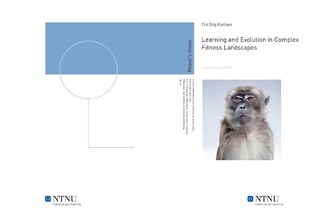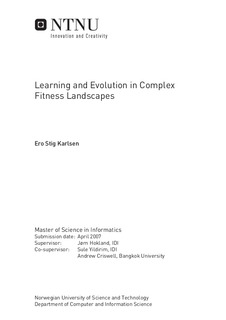| dc.contributor.advisor | Hokland, Jørn | nb_NO |
| dc.contributor.advisor | Yildirim, Sule | nb_NO |
| dc.contributor.advisor | Criswell, Andrew | nb_NO |
| dc.contributor.author | Karlsen, Ero Stig | nb_NO |
| dc.date.accessioned | 2014-12-19T13:31:38Z | |
| dc.date.available | 2014-12-19T13:31:38Z | |
| dc.date.created | 2010-09-03 | nb_NO |
| dc.date.issued | 2007 | nb_NO |
| dc.identifier | 347445 | nb_NO |
| dc.identifier | ntnudaim:1267 | nb_NO |
| dc.identifier.uri | http://hdl.handle.net/11250/250424 | |
| dc.description.abstract | The Baldwin effect is the notion that life time adaptation can speed up evolution by 1) identifying good traits and 2) by genetic assimilation inscribing the traits in the population genetically. This thesis investigates the Baldwin effect by giving an introduction to its history, its current status in evolutionary biology and by reviewing some important experiments on the Baldwin effect in artificial life. It is shown that the Baldwin effect is perceived differently in the two fields; in evolutionary biology the phenomenon is surrounded by controversy, while the approach in artificial life seems to be more straight forward. Numerous computer simulations of the Baldwin effect have been conducted, and most report positive findings. I argue that the Baldwin effect has been interpreted differently in the literature, and that a more well-defined approach is needed. An experiment is performed where the effect of learning on evolution is observed in fitness landscapes of different complexity and with different learning costs. It is shown that the choice of operators and parameter settings are important when assessing the Baldwin effect in computer simulations. In particular I find that mutation has an important impact on the Baldwin effect. I argue that today's computer simulations are too abstract to serve as empirical evidence for the Baldwin effect, but that they nevertheless can be valuable indications of the phenomenon in nature. To assure the soundness of experiments on the Baldwin effect, the assumptions and choices made in the implementations need to be clarified and critically discussed. One important aspect is to compare the different experiments and their interpretations in an attempt to assess the coherence between the different simulations. | nb_NO |
| dc.language | eng | nb_NO |
| dc.publisher | Institutt for datateknikk og informasjonsvitenskap | nb_NO |
| dc.subject | ntnudaim | no_NO |
| dc.subject | MIT informatikk | no_NO |
| dc.subject | Kunstig intelligens og læring | no_NO |
| dc.title | Learning and Evolution in Complex Fitness Landscapes | nb_NO |
| dc.type | Master thesis | nb_NO |
| dc.source.pagenumber | 84 | nb_NO |
| dc.contributor.department | Norges teknisk-naturvitenskapelige universitet, Fakultet for informasjonsteknologi, matematikk og elektroteknikk, Institutt for datateknikk og informasjonsvitenskap | nb_NO |

